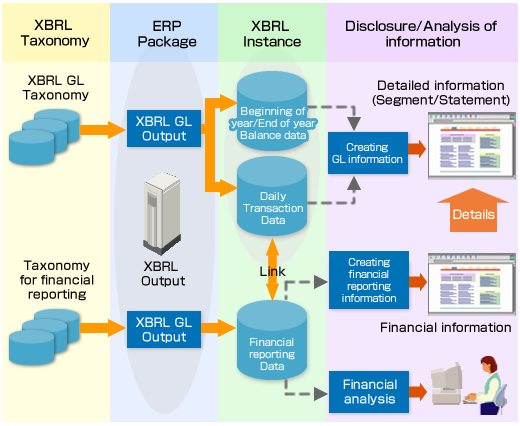Information of event
XBRL Specifications
| |1|2|Collaboration between XBRL GL and Financial Reporting|4|5| | ||
XBRL GL contains detailed informations required for financial activities' reporting, and used for recording as internal reporting independent from diverse financial reporting formats in which systems are different. Thus, using the data recoded with XBRL GL, you can create financial information according to the purposes: accounting audits, budgeting, external reporting, etc.
For example, if subjects for external reporting are defined as the value aggregated with XBRL GL, the subject values stated in an account statement can be easily recognized from which GL data they are aggregated. As stated above, defining correspondence relations for each usage enables diverse and individual values in financial reporting to be confirmed what items comprises them.
As shown in Figure 3, defined correspondence relations between daily trading data stored in existing financial account packages (ERP packages) and financial reporting information for which financial reporting instances are aggregated, you can drill down on more detail information from subjects of financial reporting.
Thus, subjects of financial reporting and the detailed information as items are displayed with association, XBRL GL can be used as an effective method for improving efficiency of the processes in consolidated accounts, accounting audits, and financial/management analysis.
Figure 3 Using and collaborating

XBRL GL is based on XBRL specification, and can be used for expressing detailed business transaction information by XBRL taxonomies and instance document including relations between items. It provides standard data specifications in internal reporting, enabling information of various business systems to be converted into common expressions. As a result, it is possible to transform existing complex correspondence relations of N x M that source information and applications are related one by one into a simple relasions ot N + M.

Using these data architectures, it has also become possible to extend systems corresponding to the needs of information interactions with a variety of systems in conformity with the business model change such as merger and acquisition business, and make business judgments by monitoring the business activities uniformly.
![]()
| |1|2|Collaboration between XBRL GL and Financial Reporting|4|5| |